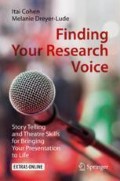Abstract
The shape of your story is a critical component in effectively transmitting your core message and inspiring interest in your research. Many researchers make the mistake of assuming that presenting the facts in a logical, sequential manner will be the most effective way to convey the content of their work and the professionalism of their approach. The problem is your audience may be asleep before you communicate your essential finding and may remember little of what you worked so hard to tell them. When someone steps into a room (a theater, a lecture hall, a conference auditorium) and sits down to listen to a speaker who will be engaging their attention for a period of time, they unconsciously begin to expect certain storytelling events to happen. They expect the speaker to peak their curiosity, transport them to another place, and keep them wondering how the story will end (Heath & Heath, 2007).
Access this chapter
Tax calculation will be finalised at checkout
Purchases are for personal use only
References
Cohen, I. (2019). Flight of the fruit fly Physical Review Fluids, 4(11), 110503.
Gallo, C. (2014). Talk like TED: The 9 public speaking secrets of the world’s top minds. London: Pan Macmillan.
Heath, C., & Heath, D. (2007). Made to stick: why some ideas survive and others die. New York: Random House.
McKee, R. (1997). Story: Style, structure, substance, and the principles of screenwriting. New York: Harper Collins.
Meyers, P., & Nix, S. (2011). As we speak: How to make your point and have it stick. New York: Simon and Schuster.
Reynolds, G. (2012). Presentation Zen: Simple ideas on presentation design and delivery. San Francisco: New Riders.
Thomas, J. (2013). Script analysis for actors, directors, and designers. Boca Raton, FL: CRC Press.
Zak, P. (2012). How the dramatic arc can change our brain chemistry and spur us to action. https://futureofstorytelling.org/video/paul-zak-empathy-neurochemistry-and-the-dramatic-arc
Author information
Authors and Affiliations
Electronic Supplementary Material
Flight of the Fruit Fly. Full lecture delivered at the 71st Annual Meeting of the APS DFD. (PDF 10,186 kb)
Rights and permissions
Copyright information
© 2019 Springer Nature Switzerland AG
About this chapter
Cite this chapter
Cohen, I., Dreyer-Lude, M. (2019). Shaping the Dramatic Arc. In: Finding Your Research Voice. Springer, Cham. https://doi.org/10.1007/978-3-030-31520-7_3
Download citation
DOI: https://doi.org/10.1007/978-3-030-31520-7_3
Published:
Publisher Name: Springer, Cham
Print ISBN: 978-3-030-31519-1
Online ISBN: 978-3-030-31520-7
eBook Packages: Physics and AstronomyPhysics and Astronomy (R0)

